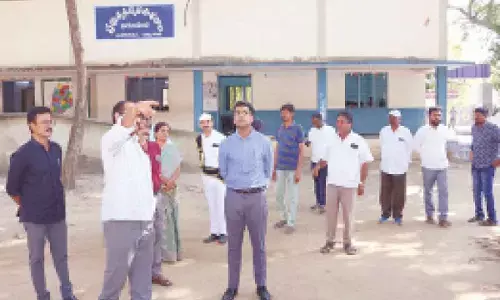Challenges of Centre's new national education policy

Challenges of Centre’s new national education policy
The recent National Education Policy (NEP) approved by the Central government is promising sea changes in the education system of the country.
The recent National Education Policy (NEP) approved by the Central government is promising sea changes in the education system of the country. Though some intellectuals lost no time in praising this 484-page policy framework, others have cautiously but strongly expressed their objective view that not all changes proposed are desirable and may not be able to be implemented in the present politico-economic set up. However, it should be mentioned that there has been no in-depth brainstorming on this policy by the educationists, social scientists and political stakeholders in Telangana State. In the wake of the announcement of the Chief Minister K Chandrashekar Rao that a new policy for Telangana is in the offing, this issue has definitely gained new importance.
The NEP only provides a broad direction and is not mandatory to follow. Since education is a concurrent subject (both the Centre and the State governments can make laws on it), the reforms proposed can only be implemented collaboratively by the Centre and the States. The proposal to increase allocations to education sector from the present 1.7% to 6% of GDP is highly appreciable, which has to be implemented by both the Center and the State governments. The incumbent government has set a target of 2040 to implement the entire policy.
Concerning higher education, the proposed 4-year course, measuring the students' performance by credit points, providing exit possibility from courses or partially taking part in them, choice of curriculum incorporating humanities, social sciences, scientific and technical subjects etc. are in line with globalisation trends. This facilitates number of foreign universities to work in India.
There is indeed a strong necessity of integrating vocational education in the system, however, if skills and technology are one pair, study and research are the other pair. One cannot ignore them. This is also a big challenge before us. One can visualise the emerging contradictions between the objectives of Right to Education and National Education Policy. The conflicting interest of the State and the market in higher education is essential to understand the functioning of a university. For example, there is no attempt made in the NEP to control the private education sector. On the contrary, it has suggested freehand for them to decide about the fee structure. Given this background, it becomes very necessary to study and analyse the objectives, methods, implementation strategies of the privatisation of the education sector and its implications on our children and the society as well as systems which promote this sector from the politico economic perspective.
In a letter to Mahatma Gandhi, Rabindranath Tagore compared his educational experiment at Santi Niketan to a vessel carrying the cargo of his "life's best treasure." He spent forty years of his life establishing Vishwa-Bharati, which had wide influence in Europe, Japan and the United States. It was a unique educational institution, which emphasised the education as holistic and of the whole person. Sadly, in today's India, his ideas about education do not find an appropriate place.
The commoditisation of higher education has gained acceptance in the last decades. In India, there has been a paradigm shift in the Twelfth Five Year Plan (2012- 2017) of higher education for "For-Profit Institutions". The Twelfth Five Year Plan has favored an approach that has endorsed private capital in higher education with an eye on profit generation. Many States, including Telangana have endorsed it and have even granted permissions for private universities.
It is astonishing to see today an array of individuals and societies such as corporate companies, religious organisations, hoteliers, realtors, and liquor barons offer private higher education in the country. In India, the so-called "meritorious" students endowed with cultural capital are admitted to subsidised public institutions of learning, which are relatively of higher quality, while the rest join in low-quality mass private institutions that charge huge fees, also known as self-financing. Unfortunately, the development of differentiated or stratified higher education system is not challenged at a significant level in a democratic country like India. Instead, the government is encouraging and partly supporting through affirmative action policies of entry of the market in higher education such as through fee reimbursement. The user pay principle which has led to the dominance of the freedom to choose the product over the freedom to choose the provider partly explains the mushrooming of private institutions offering market-oriented professional courses. If education ceases to be supported by the government, then education no longer can serve the larger interests of people. How come that though we have presently excellent long-term strategic programs such as Mission Kakatiya (Resource Economics), Haritha Haram (Environmental Economics), Revenue and Administrative Reforms (Institutional Economics), Rytu Bandhu & Rytu Samanvaya Samiti (Political and Social Science), Mission Bhageeratha & irrigating one crore acre through Kaleshwaram (Sustainability) which are neither integrated in education nor in research programmes at our colleges and universities?
The conflicting interest of the State and the market in higher education is essential to understand the functioning of a university. The motive of the former is to serve society while the objective of the latter is to serve the private interests of students/consumers/clients. Earlier, in the sphere of teaching, learning used to be across the spectrum of disciplines without a perfect symmetry or homogeneity. Today's situation is that students and parents show strong favoritism for profit-oriented homogenous curriculum, which will make their children employable. In this way, market shapes the popularity and availability of courses to the students such as short-term vocational and specialised courses to draw lucrative fees. Likewise, market drives the research agenda of the universities as resources for research in life sciences, medicine, engineering or economics are abundant while resources for research in philosophy, linguistics, history, sociology, environment and literature are scarce. The current international debate on "21st-century skills", also in the backdrop of current corona pandemic, between (a) purely knowledge-oriented view of education and oppose recent shifts towards (b) competency-based approaches in education gains high importance. That means, in solving problems that are usually complex, humans have to apply knowledge — often incomplete knowledge — in contexts where the conditions are often uncertain in order to offer a practical solution to a real-world challenge. Problem-solving is often referred to as a cross-curricular competence in the sense that solving problems in the real world obliges people to draw on deep levels of knowledge and outstanding analytical capabilities from different fields and disciplines.
The new trends of "philanthropic consultants" and "volunteerism" practices fit into the neoliberal economic system. New ways of organising the gifting of time and money are growing at an extraordinary rate. These legitimise the neoliberal economic and political system by providing the "human face" of the market. It looks as though the conventional leaders have perfected the art of concealing the outward appearance as real. Philanthropic involvement appears as voicing the aspiration to cut the State involvement from welfare, whether education or health: this makes the State not to provide certain basic fundamental services to its citizens and explain that there is no need for it to do so as private agents will take care of them. In this neo-philanthropic era, philanthropy has become a welfare part of market activities, thus making partial withdrawal of the State in education or health legitimate. However, experience from all the world and our own experience convincingly shows that education as also health should be considered as public goods and not private goods and the vital services arising out of them have to be provided by a modern welfare state in the more accessible form to all its people. Given this, are we in a position to mold the national education policy to achieve these objectives?
(The writer is member of Telangana Legislative Assembly and
Humboldt expert in Agriculture, Environment and Cooperation.
Views expressed are personal)



















